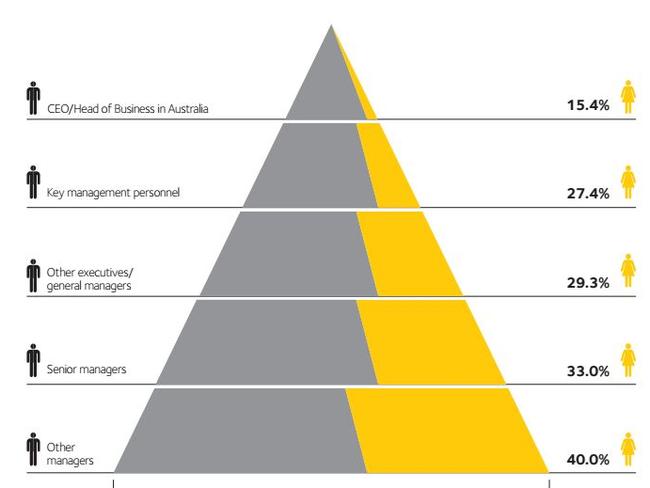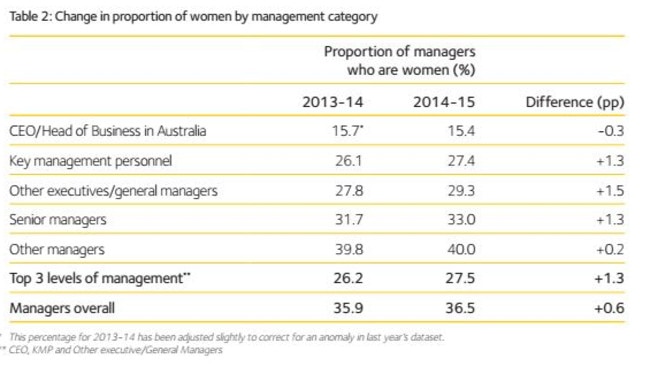Workplace gender equality scorecard puts Australia to shame
THIS is Australia’s triangle of shame. It’s just one depressing take-out in a report that shows women are being dudded.
THIS is Australia’s triangle of shame.
In a depressing report on the state of gender equality in our workplaces, the shocking graphic shows the representation of women in management positions.
See that yellow sliver to the side there? That shows the proportion of women in management jobs. That tiny, little sliver.
The Workplace Gender Equality Agency’s second annual scorecard covering nearly 4 million workers across 12,229 employers in Australia, confirms the persistence of gender pay gaps and the concentration of women in lower-paying jobs and industries.

Looking at the make-up of management-level positions, the data shows 36.5 per cent of managers overall are female, but you’ll notice on the graph the sliver narrows at the top, where women make up only 15.4 per cent of chief executive officer or head of business positions.
Proof the representation of women declines with seniority is just one depressing takeout of a report that will shock and shame Australian employers.
The overall gender pay gap for fulltime workers is 24 per cent, meaning men earn an average total of $27,000 a year more than women.
The gap is even higher for female managers, excluding CEOs, who take home 29 per cent less than their male counterparts.
There was a slight growth in women’s management representation with 27.5 per cent of key management positions held by women.
Breaking those positions down showed a quarter (25.1 per cent) of organisations have no females in key management positions (KMPs), and one in five (19.4 per cent) have no “other executives/general managers”, a step down from KMPs, who are women.

In contrast, 4.2 per cent of organisations have no male key management personnel and 3.9 per cent of organisations have no male “others”.
When it came to flexible work, more employers were found to be introducing guidelines for flexible working with 60.2 per cent of companies on board compares with 57.5 per cent last year, though only 14.6 have a formal strategy in place.
The shift towards facilitating flexible work is good news for women, who still work part-time at three times the rate of men.
Part-time positions for both men and women were higher than last year, though the scorecard showed part-time workers were excluded from management opportunities with only 6.3 per cent of those positions filled by part-time workers.
WGEA also analysed gender compositions in each industry, with blue-collar industries predictably still male-dominated, while women were concentrated in health, education and retail.
“Gender segregation is one contributing factor to the overall gender pay gap, with female-dominated industries traditionally offering lower pay than male-dominated industries,” the report observes.
The scorecard also showed a fifth of employers have a gender equality strategy in place — this has grown from 18.3 per cent to 20.6 per cent from the previous year.
But by the look of these results, those strategies could do with some work.




